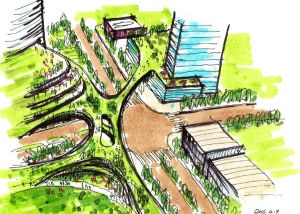Published April 13 2016
Also, refinements to false alarm reduction program considered
Plans to transform a stretch of Bellevue between the Meydenbauer Bay waterfront and the Eastside Rail Corridor into a "Grand Connection" took a leap forward with ideas suggested over the weekend by top architects, planners and artists.
The entire City Council Monday spoke in support of a design charrette co-hosted by the city and the Bellevue Arts Museum, which drew 80 design professionals on Thursday, Friday and Saturday.
"I think it's really amazing," Mayor John Stokes said after a presentation from Planning & Community Development staff about the charrette. "I believe this community will really be excited."
In December the council approved the start of an effort to develop a landmark pedestrian route through the city and over Interstate 405. The Grand Connection is a transformative idea for community connectivity and place-making. In March, the council approved the hiring of New York-based landscape design firm Balmori Associates to lead the visioning phase of the project.
For the charrette, architects, planners and artists from top firms volunteered their time to come up with ideas for segments of the Grand Connection. While it is too early to adopt any scheme, planner Bradley Calvert told the council the concepts from the event are energizing the process. Drawings and other products from the charrette will soon be posted online and available for viewing at City Hall.
Refinements to false alarm reduction program considered
When the city rolled out a false alarm reduction program in October, problems with the registration process triggered complaints from many residents. Under orders from the city, the vendor contracted to administer the program made many fixes. The program was resumed in March, after a three-month suspension.
The council on Monday considered additional improvements. While several councilmembers criticized the early problems associated with the program, the majority leaned toward making minor fixes rather than abandoning it.
The program was launched to reduce the number of false alarms, which take time and resources for police officers to check. The Bellevue police have been handling approximately 3,300 false alarms per year, which equates to 1,700 hours of patrol time. Approximately 98 percent of all alarm calls in the city are false.
Last year the city hired Public Safety Corporation to administer the program, using a software called "CryWolf." However, residents voiced concerns over the registration fee and whether or not the materials they received were official. In response, PSC made a number of changes, including having all forms and notices reviewed by the police before sending them to residents, fixing the online registration website and ensuring customers know when its offices are closed.
Since the start of the program in October, Police Chief Steve Mylett told the council that false alarms have dropped by 9 percent. The police aim for the rate to ultimately drop by 50 percent after a year of full operation, based on statistics of other jurisdictions that operate false alarm programs.
The council considered further refinements to the program and related ordinance Monday, including changing the annual registration fee to a one-time fee and possibly having graduated fines for repeat false alarms. The police department will come back with possible revisions for the council's approval at a later date

